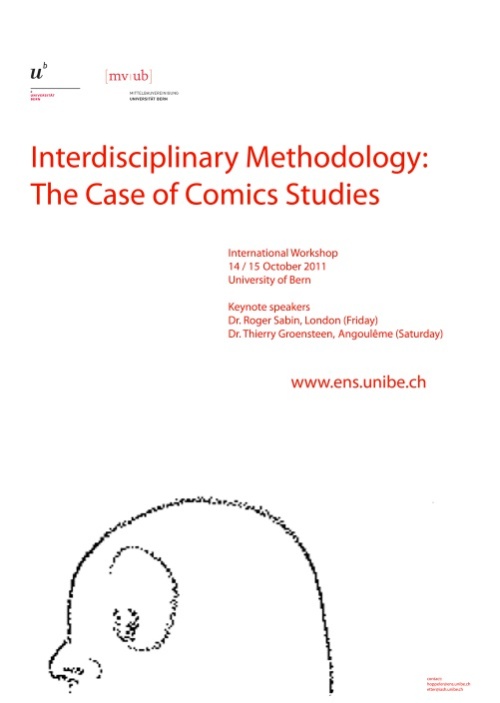Stephanie Hoppeler, Lukas Etter, and Gabriele Rippl (whose research project “Seriality and Intermediality in Graphic Novels” is associated with the DFG Research Unit “Popular Seriality–Aesthetics and Praxis”) have put together a workshop titled “Interdisciplinary Methodology: The Case of Comics Studies,” which will take place on October 14-15, 2011 in Bern. In the organizers’ own words:
“Our motivation for this event is to reduce what we see as a stark discrepancy between the popularity of Comics Studies on the one hand and the virtual lack of encompassing methodological reflection on the other.
We have planned one keynote speech for each of the two days: Dr. Thierry Groensteeen (freelance lecturer and curator; founder of www.citebd.org) will hold an introductory speech on Friday 14 October, and Dr. Roger Sabin (lecturer at Central St. Martins University of the Arts, London) will give a paper on Saturday 15 October. Each speech shall be followed by several thematic panels, in which researchers will present their papers and thereby introduce a broader discussion.
[Papers have been chosen that] include or stimulate reflection on the methodological issues Comics Studies and Intermediality Studies raise, as well as on possibilities to tackle these issues.”
One of those papers will be presented by yours truly. The paper develops the phenomenological approach to comics that was implicit in my paper at the DGfA conference this year in Regensburg, “Frame, Sequence, Medium: Comics in Plurimedial and Transnational Perspective” (screencast video here, in case you missed it). In particular, my talk in Bern will expand on the notion of the “multistable frame,” which I introduced as a way of talking about comics and their emergent serialities in the earlier paper. Here is the abstract for my presentation in Bern:
Multistable Frames: Notes Towards a (Post-)Phenomenological Approach to Comics
Shane Denson
“In the available accounts of the theories and methods of popular culture studies, phenomenology is conspicuously absent” (Carroll, Tafoya, and Nagel 1)—thus observe the editors of a volume meant to rectify that situation, published in the year 2000. But over a decade later their statement remains largely true. In the meantime, popular culture itself has changed, as have the studies devoted to it: new theories and methods have emerged, and different phenomena have come into view. Developments in and around comics and graphic novels are exemplary: comics themselves have been transformed through contact with digital media, their social status revised largely through the graphic novel, and they have come to exert an unprecedented influence on mainstream cinema and television. Today, comics cannot be ignored, neither in the broad field of popular culture nor in the more specialized realms of academic study: increasingly, comics are being researched with a great variety of methods by literary scholars, historians of art and culture, media theorists, and even philosophers. Looking back from this vantage point, we may find the absence of phenomenology among fin-de-millennium approaches to popular culture less surprising than the conspicuous absence of comics in a volume dedicated to Phenomenological Approaches to Popular Culture. Phenomenology and comics, or so it would seem, pass like ships in the night—and this despite the fact that the insights of some of the seminal works on comics, such as Will Eisner’s Comics and Sequential Art and Scott McCloud’s Understanding Comics, were arrived at through methods and means of looking at comics that were implicitly phenomenological in nature. It remains, then, to make these methods explicit, and to transform phenomenological insights into a genuine methodology available for the study of comics. As a first step towards this goal, I propose rethinking Eisner’s and McCloud’s classic contributions through the lens of categories and concepts developed by American philosopher Don Ihde for the phenomenological study of “mediating technologies.” Adapted to the medium of comics, and applied specifically to the central figure of the frame that, in various forms (e.g. panels, speech balloons, pages as meta-panels), dominates Eisner’s and McCloud’s analyses of comics as a sequential art, Ihde’s phenomenological categories lend greater depth to our understanding of comics as an experiential domain, throwing phenomena like the achievement of “closure” (as McCloud puts it) between panels into sharper relief, but at the same time revealing the requisite negotiations between and amongst frames and the internal and external spaces they define as a highly complex process. The apparently simple act of reading comics, that is, is revealed as a highly complex process, one involving a non-linear dynamics that can be traced back to the recursive nestings and reversibilities of frames as phenomenal objects. Ultimately, the multistability of comics’ framings, as revealed in a phenomenological analysis, points towards the logic of flickering oscillations that Derrida has exposed under the rubric of the parergon, and hence to a postphenomenological approach that destabilizes any categorical difference between subjects (or readers) and objects (or comics). Nevertheless, a phenomenological methodology may prove to be the only route to understanding the irreducible experiential entanglements involved in our transactions with comics as a medium of the multistable frame.
Carroll, Michael T., Eddie Tafoya, and Chris Nagel. “Introduction: Being and Being Entertained: Phenomenology and the Study of Popular Culture.” Phenomenological Approaches to Popular Culture. Eds. Michael T. Carroll and Eddie Tafoya. Bowling Green: Bowling Green State University Popular Press, 2000. 1-18.
Derrida, Jacques. The Truth in Painting. Trans. by Geoff Bennington and Ian McLeod. Chicago: U of Chicago P, 1987.
Eisner, Will. Comics and Sequential Art. Rev. ed. New York: Norton, 2008.
Ihde, Don. Technics and Praxis. Dordrecht: Reidel, 1979.
_____. Technology and the Lifeworld: From Garden to Earth. Bloomington: Indiana UP, 1990.
McCloud, Scott. Understanding Comics: The Invisible Art. New York: HarperPerennial, 1993.

0 thoughts on “Multistable Frames”